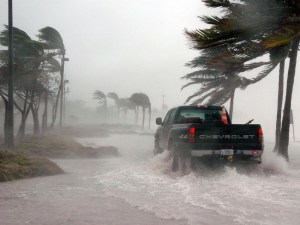What CRE Execs Need to Know About Sea Level Rise and the Law
Sea levels are rising. Emily Lamond of the Cole Schotz law firm explores the legal implications for the industry.
The U.S. coastline will see about 10 to 12 inches of sea level rise between 2020 and 2050, which is as much as the rise measured over the previous 100 years. According to a recent report from National Oceanic and Atmospheric Administration’s National Ocean Services, the sea level rise will occur through coastal flooding, meaning that tide and storm surge heights will increase and reach further inland. By 2050, the report’s authors predict, moderate flooding—that which results in damages—is expected to occur 10 times more often than it does today and can be further intensified by local factors.
READ ALSO: Climate Change—A Story of Water, Conservation, Technology
Of course, current and future carbon emissions also matter. About 2 feet of sea level rise along the U.S. coastline is increasingly likely between 2020 and 2100 because of fossil fuel use. Failing to curb future emissions could cause an additional 1.5 feet to 5 feet of rising for a total of 3.5 feet to seven feet by the end of this century, according to the National Oceanic and Atmospheric Administration’s National Ocean Service study.
In addition to the hefty costs caused by natural disasters, rising sea level translates into significant changes to land use permitting and implies key considerations for industry stakeholders to ensure that they are in compliance with permit requirements and changes. In this interview, Emily Lamond, a member of the environmental department at the law firm Cole Schotz, discusses the legal implications of rising sea levels for real estate.
How do the findings of the National Ocean Services’ report reverberate across the real estate industry?
Lamond: The ripple effects of sea level rise projections are already being seen in the commercial real estate industry, and elevation is the name of the game. Developers are trucking in dirt to raise elevation and increase freeboard. Buildings, roads, substations and other critical infrastructure in coastal areas are finding higher ground.
Tenants, buyers, lenders and investors are looking for resilient buildings. Additionally, municipal planning boards, local building codes, state permitting agencies and other regulators are increasingly pushing for more flood mitigation measures. Commercial real estate development projects in coastal areas are being planned for and priced accordingly.
The definition of coastline varies from one state to another, but once land is “submerged” it becomes part of the public trust. How does this ownership shift take place? What does it mean for the owner “forced” to turn ownership over to the local or state government?
Lamond: Every lawyer’s favorite answer: It depends. If the land becomes submerged as a result of a storm or other sudden and unexpected change in the coastline, the upland owner may be able to retain ownership of the newly submerged land under the “avulsion” doctrine.
On the other hand, if the land becomes submerged as a result of erosion over time, the state takes the title from the upland property owner for that newly submerged land. The opposite is true: When new dry land is gradually created through accretion—the upland property owner takes the title from the state for the new dry land.
Bear in mind, however, that a state’s ownership of submerged land is derived from common law, and there can be significant variation state by state.
What happens when a coastal property is inundated and can no longer be used? Who bears the liability to remove or pay damages?
Lamond: If the ocean knocks down your door, you will likely be responsible for the resulting damage. With no direct authority imposing liability on states or municipalities to remove structures or pay damages in such a situation, property owners in high-risk areas for inundation should assess their insurance coverage and, frankly, be ready for unexpected costs.
What tools do property owners currently have to protect their assets located in risk areas?
Lamond: Elevation and engineering. If you’ve recently gone for a drive along the coast, you most likely saw more than one home being raised onto pilings or columns.
Wet floodproofing is another option. This entails creating a space in an unoccupied area of a building—oftentimes called a flood vent—that will allow floodwaters to flow through and reduce the extent of structural damage.
Property owners can also install watertight doors and windows, apply waterproof sealant and upgrade and maintain stormwater management infrastructures such as basins and drainage features. Flood walls are increasing in popularity, but remember the water needs to go somewhere so be mindful of common law prohibitions against diverting damaging floodwaters onto other properties.
What about developers looking to build or redevelop projects in high-risk coastal areas such as Virginia or Florida?
Lamond: Again, elevation and engineering. In addition to the tools just mentioned, developers can employ several strategies such as elevated mechanicals, stormwater management engineering, green roofs, sea walls, permeable pavement, concrete designed to withstand saltwater corrosion etc.
Diligence is also critical. Developers should do due diligence on both current and projected flood risks for the project site and the surrounding area early in the process, even before entering a contract if possible.
Considering that real estate is a long-term investment and that 2050 is less than a 30-year mortgage away, what should investors consider when conducting research on a potential investment?
Lamond: Flood vulnerability of a property and the surrounding area should be evaluated early in the research process as a threshold matter. Sea level rise risks will be exacerbated by the increasing intensity and frequency of storms, so investors should be asking if the project can keep the lights on and continue to generate revenue when big storms hit.
Is the access road above projected flood hazard levels? Are the mechanicals elevated? Is the electricity source vulnerable? High-risk properties may also warrant reserves for flood damage repair, implementation of mitigation and resiliency strategies, and ongoing maintenance and upgrades.
Let’s talk about the current permit requirements. Have they been altered due to environmental concerns?
Lamond: Environmental permitting requirements evolve over time, changing to address new issues arising from environmental concerns, market conditions, technologies, risks, scientific developments and more. Sea level rise is no exception. Many coastal states and municipalities are evaluating ways to mitigate and manage the risks posed by sea level rise through the lens of their permitting regimes.
One example is New Jersey’s Resilient Environments and Landscapes initiative, which is part of a larger Protecting Against Climate Threats program. Under REAL, the New Jersey Department of Environmental Protection is in the process of revising its entire land use permitting program—wetlands, flood hazard, stormwater and coastal—to address, among other climate change risks, sea level rise.
Are these measures designed to resolve the impact of rising sea levels in the long term or is it more of a short-term issue solution?
Lamond: Some regulators are proposing longer time frames, with an eye towards projected conditions in the next 50+ years. The regulated community is largely pushing back, and we expect to ultimately see more of a middle ground by the time updates to regulatory programs are finalized.
Last year, Hawaii became the first state in the U.S. to pass a law requiring sea level rise disclosures in real estate transactions. What does this mean for the real estate industry and should we expect other states to follow suit?
Lamond: For the most part, the commercial world, especially in the development space, is aware of the sea level rise risks and is planning and pricing projects accordingly. It will be most interesting to see how lenders and investors react as these disclosures start coming across their desks. We expect at least a few coastal states will follow suit in the near term.








You must be logged in to post a comment.